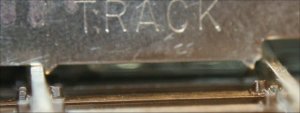Hey guys,
This weekend I was working on replacing a broken curved Peco turnout and I decided to try out the better looking Walthers Code 83 32"/36" radius right hand #8 curved turnout it its place. This looked like a really good option, because this turnout is used where my single track mainline splits into a double track line, so it gets a lot of traffic, has to be reliable, and the gentle curves are easy on the eyes and should be less prone to derail.
However, before installing it, I checked it over with an NMRA gauge since I had a little trouble connecting it to the flex track. I should do this every time, but I confess that I don't always think of it. I was shocked to discover that just before the points, the NO-GO part of the gauge dropped easily between the rails. (see attachment)
A quick measurement with the calipers showed that the actual gauge was .6785", well beyond than the NMRA maximum of .672". I do run some fine scale wheelsets, although on a curve this could potentially wreak havoc on any type of wheelset.
I called Walthers about this today, and they said they hadn't heard of this before. Have any of you discovered this yourselves? Of course they suggested I return it for an exchange (I bought these from M.B. Klein half way across the U.S.) but since I have two of them and they both measure the same, wouldn't I likely just get two more defective turnouts?
This weekend I was working on replacing a broken curved Peco turnout and I decided to try out the better looking Walthers Code 83 32"/36" radius right hand #8 curved turnout it its place. This looked like a really good option, because this turnout is used where my single track mainline splits into a double track line, so it gets a lot of traffic, has to be reliable, and the gentle curves are easy on the eyes and should be less prone to derail.
However, before installing it, I checked it over with an NMRA gauge since I had a little trouble connecting it to the flex track. I should do this every time, but I confess that I don't always think of it. I was shocked to discover that just before the points, the NO-GO part of the gauge dropped easily between the rails. (see attachment)
A quick measurement with the calipers showed that the actual gauge was .6785", well beyond than the NMRA maximum of .672". I do run some fine scale wheelsets, although on a curve this could potentially wreak havoc on any type of wheelset.
I called Walthers about this today, and they said they hadn't heard of this before. Have any of you discovered this yourselves? Of course they suggested I return it for an exchange (I bought these from M.B. Klein half way across the U.S.) but since I have two of them and they both measure the same, wouldn't I likely just get two more defective turnouts?







